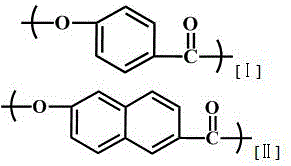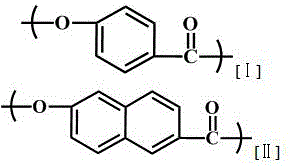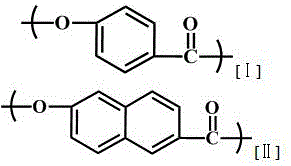Liquid crystal polyester, molding composition composed of liquid crystal polyester and application of molding composition
A molding composition, liquid crystal polyester technology, applied in the directions of liquid crystal materials, chemical instruments and methods, etc., can solve the problems affecting the application of liquid crystal polymers, poor melt processability and physical properties of liquid crystal products, and unsatisfactory mold filling.
- Summary
- Abstract
- Description
- Claims
- Application Information
AI Technical Summary
Problems solved by technology
Method used
Image
Examples
Embodiment 1
[0073] Add the following monomer raw materials, acylating agent and catalyst to the polymerization reaction device equipped with agitator, reflux condenser, monomer feeding port, nitrogen inlet, thermometer and torque sensor.
[0074] (I) p-Hydroxybenzoic acid 911.7 g (66 mol %) HBA
[0075] (Ⅱ) 6-hydroxy-2-naphthoic acid 639.8 g (34mol%) HNA
[0076] Acylating agent: acetic anhydride 1020 g
[0077] Catalyst: Magnesium acetate 95 mg
[0078] After the feeding is completed, completely replace the atmosphere in the reaction vessel with nitrogen, raise the temperature of the reaction system to 140°C under the protection of nitrogen, and keep the nitrogen pressure at 0.2MPa, and maintain this temperature for 2 hours to carry out the acylation reaction; acylation After the reaction is over, turn on the vacuum pump to reduce the pressure in the reactor to 10KPa-30KPa, and quickly discharge acetic acid and unreacted acetic anhydride molecules from the rectification column to meet ...
Embodiment 2-5
[0079]Embodiment 2-5: After finishing according to the prescription acylation reaction of table 1, open vacuum pump and depressurize the pressure in reactor to 10KPa-30KPa, discharge acetic acid and unreacted acetic anhydride molecule rapidly from rectifying column, in order to meet rapid temperature rise According to the technical requirements, when the amount of acetic acid received reaches more than 50% of the theoretical value, the temperature is rapidly raised to 210°C, the reduced pressure condition is maintained and the temperature of the reaction system is raised to the highest temperature of 330°C within 6 hours, during which the acetic acid, especially phenol, is continuously discharged Wait for the by-product small molecules that cause molecular chain rearrangement and branching, and then reduce the pressure to 60KPa in 30 minutes; the rest are the same as in Example 1; The lengths are listed in Table 1.
Embodiment 6-12
[0081] Comparative Examples 1-3: After the feeding is completed, the atmosphere in the reaction vessel is completely replaced with nitrogen, and the temperature of the reaction system is raised to 140° C. under the protection of nitrogen, and the temperature is maintained at reflux for 2 hours to carry out the acylation reaction; the acylation reaction After the end, discharge acetic acid and unreacted acetic anhydride molecules from the rectification column, while raising the temperature and raising the temperature of the reaction system to 325°C within 6 hours, during which the acetic acid is continuously discharged, and then decompressed to 30KPa within 30 minutes; when stirring After the torque reaches the predetermined value, it is considered that the reaction is over, and the product in the reactor is taken out at this time; after the product is cooled to room temperature, it is pulverized with a pulverizer, and then heated from room temperature to 250 ° C within 10 hour...
PUM
 Login to View More
Login to View More Abstract
Description
Claims
Application Information
 Login to View More
Login to View More - R&D
- Intellectual Property
- Life Sciences
- Materials
- Tech Scout
- Unparalleled Data Quality
- Higher Quality Content
- 60% Fewer Hallucinations
Browse by: Latest US Patents, China's latest patents, Technical Efficacy Thesaurus, Application Domain, Technology Topic, Popular Technical Reports.
© 2025 PatSnap. All rights reserved.Legal|Privacy policy|Modern Slavery Act Transparency Statement|Sitemap|About US| Contact US: help@patsnap.com



